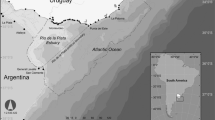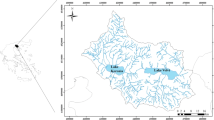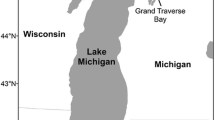Abstract
We modeled energy transfer and trophic position of fish, plankton, and macroinvertebrates and the relative importance of top-down versus bottom-up processes in Lake Võrtsjärv, a large shallow eutrophic lake in Estonia (northeastern Europe). We employed input values based on 37 years of biomass and fishing activity monitoring for calibrating the Ecopath with Ecosim (EwE) model. Energy flows from primary producers and detritus, represented by total system throughput, were nearly equal (51 and 49%, respectively). Simulation revealed that top-down and bottom-up forces were at play, metazooplankton was not efficiently grazing phytoplankton production, and a trophic cascade proceeded through macroinvertebrates rather than through zooplankton. Detritivory was responsible for the relatively low trophic position of Võrtsjärv fish compared to other lakes. Bottom-up processes were the main drivers for the dual, primary production- and detritus-based pathways in energy flow. Our findings suggest that the predicted biomass increase of cyanobacteria in shallow lakes in the future will strengthen the reliance of consumers on the detrital pathway at the expense of the primary production pathway.





Similar content being viewed by others
References
Alexander, K. A., J. J. Heymans, S. Magill, M. T. Tomczak, S. J. Holmes & T. A. Wilding, 2015. Investigating the recent decline in gadoid stocks in the west of Scotland shelf ecosystem using a foodweb model. ICES Journal of Marine Science 72: 436–449.
Andersson, E. & S. Sobek, 2006. Comparison of a mass balance and an ecosystem model approach when evaluating the carbon cycling in a lake ecosystem. Ambio 35: 476–483.
Attayde, J. L. & J. Ripa, 2008. The coupling between grazing and detritus food chains and the strength of trophic cascades across a gradient of nutrient enrichment. Ecosystems 11: 980–990.
Brey, T., 1999. A collection of empirical relations for use in ecological modelling. NAGA the ICLARM Quaterly 22: 24–28.
Brey T., 2001. Population dynamics in benthic invertebrates. A virtual handbook. http://thomas-brey.de/science/virtualhandbook.
Bunnell, D. B., R. P. Barbiero, S. A. Ludsin, C. P. Madenjian, G. J. Warren, D. M. Dolan, T. O. Brenden, R. Briland, O. T. Gorman, J. X. He, T. H. Johengen, B. F. Lantry, B. M. Lesht, T. F. Nalepa, S. C. Riley, C. M. Riseng, T. J. Treska, I. Tsehaye, M. G. Walsh, D. M. Warner & B. C. Weidel, 2014. Changing ecosystem dynamics in the Laurentian Great Lakes: bottom-up and top-down regulation. BioScience 64: 26–39.
Carpenter, S. R., J. F. Kitchell & J. R. Hodgson, 1985. Cascading trophic interactions and lake productivity. BioScience 35: 634–639.
Carpenter, S. R., J. J. Cole, J. R. Hodgson, J. F. Kitchell, M. L. Pace, D. Bade, K. L. Cottingham, T. E. Essington, J. N. Houser & D. E. Schindler, 2001. Trophic cascades, nutrients, and lake productivity: whole-lake experiments. Ecological Monographs 71: 163–186.
Christensen, V. & C. Walters, 2004. Ecopath with Ecosim: methods, capabilities and limitations. Ecological Modelling 172: 109–139.
Cremona, F., H. Timm, H. Agasild, I. Tõnno, T. Feldmann, R. I. Jones & T. Nõges, 2014a. Benthic foodweb structure in a large shallow lake studied by stable isotope analysis. Freshwater Science 33: 885–894.
Cremona, F., T. Kõiv, V. Kisand, A. Laas, P. Zingel, H. Agasild, T. Feldmann, A. Järvalt, P. Nõges & T. Nõges, 2014b. From bacteria to piscivorous fish: estimates of whole-lake and component-specific metabolism with an ecosystem approach. PloS ONE 9: e101845.
Cremona, F., A. Laas, L. Arvola, D. Pierson, P. Nõges & T. Nõges, 2016. Numerical exploration of the planktonic to benthic primary production ratios in lakes of the Baltic Sea catchment. Ecosystems 19: 1386–1400.
Darwall, W. R. T., E. H. Allison, G. F. Turner & K. Irvine, 2010. Lake of flies, or lake of fish? A trophic model of Lake Malawi. Ecological Modelling 221: 713–727.
Froese, R. & D. Pauly D (eds), 2017. Fishbase. World wide web electronic publication, www.fishbase.org.
Grønkjær, P., C. Skov & S. Berg, 2004. Otolith-based analysis of survival and size-selective mortality of stocked 0+ year pike related to time of stocking. Journal of Fish Biology 64: 1625–1637.
Hairston Jr., N. G. & N. G. Hairston, 1993. Cause effect relationships in energy flow, trophic structure, and interspecific interactions. The American Naturalist 142: 379–411.
Heymans, J. J., M. Coll, J. S. Link, S. Mackinson, J. Steenbeek, C. Walters & V. Christensen, 2016. Best practice in Ecopath with Ecosim food-web models for ecosystem-based management. Ecological Modelling 331: 173–184.
Horppila, J., H. Peltonen, T. Malinen, E. Luokkanen & T. Kairesalo, 1998. Top-down or bottom-up effects by fish: issues of concern in biomanipulation of lakes. Restoration Ecology 6: 20–28.
Järvalt, A., 1998. Estimation of fishing mortality and abundance of pikeperch Stizostedion lucioperca (L.) in Lake Võrtsjärv, Estonia. Limnologica 28: 109–113.
Järvalt, A., A. Kangur, K. Kangur, P. Kangur & E. Pihu, 2004. Fishes and fisheries management. In Haberman, J., E. Pihu & A. Raukas (eds), Lake Võrtsjärv. Estonian Encyclopaedia Publishers, Tallinn: 281–295.
Jeppesen, E., M. Sondergaard, T. L. Lauridsen, T. A. Davidson, Z. Liu, N. Mazzeo, C. Trochine, K. Ozkan, H. S. Jensen, D. Trolle, F. Starling, X. Lazzaro, L. S. Johansson, R. Bjerring, L. Liboriussen, S. E. Larsen, F. Landkildehus & M. Meerhoff, 2012. Biomanipulation as a restoration tool to combat eutrophication: recent advances and future challenges. Advances in Ecological Research 47: 411–487.
Jeppesen, E., M. Meerhoff, T. A. Davidson, D. Trolle, M. Søndergaard, T. L. Lauridsen, M. Beklioglu, S. Brucet, P. Volta, I. Gonzalez-Bergonzoni & A. Nielsen, 2014. Climate change impacts on lakes: an integrated ecological perspective based on a multi-faceted approach, with special focus on shallow lakes. Journal of Limnology 73: 88–111.
Kangur, K., 2015. Katsemetoodika: makrozoobentose liiglise koosseisu ja biomassi määramine. Estonian University of Life Sciences (in Estonian), Centre for Limnology.
Kangur, K., A. Kangur & P. Kangur, 1999. A comparative study on the feeding of eel, Anguilla anguilla (L.), bream, Abramis brama (L.) and ruffe, Gymnocephalus cernuus (L.) in Lake Võrtsjärv, Estonia. In Shallow Lakes’ 98 (pp. 65–72). Springer Netherlands. https://doi.org/10.1007/978-94-017-2986-4_7.
Kangur, P., A. Kangur & K. Kangur, 2007. Dietary importance of various prey fishes for pikeperch Sander lucioperca (L.) in large shallow lake Võrtsjärv (Estonia). Proceedings of the Estonian Academy of Sciences: Biology, Ecology 56: 154–167.
Kavanagh, P., N. Newlands, V. Christensen & D. Pauly, 2004. Automated parameter optimization for Ecopath ecosystem models. Ecological Modelling 172: 141–149.
Link, J. S., 2010. Adding rigor to ecological network models by evaluating a set of pre-balance diagnostics: a plea for PREBAL. Ecological Modelling 221: 1580–1591.
McGregor, A. M., 2013. Using Ecopath modeling to describe historical conditions for a large, Boreal lake ecosystem prior to European Settlement. North American Journal of Fisheries Management 34: 16–29.
Moore, J. C., E. L. Berlow, D. C. Coleman, P. C. Ruiter, Q. Dong, A. Hastings, N. C. Johnson, K. S. McKann, K. Melville, P. J. Morin, K. Nadelhoffer, A. D. Rosemond, D. M. Post, J. L. Sabo, K. M. Scow, M. J. Vanni & D. H. Wall, 2004. Detritus, trophic dynamics and biodiversity. Ecology letters 7: 584–600.
Montagnes, D. J. S., D. H. Lynn, J. C. Roff & W. D. Taylor, 1988. The annual cycle of heterotrophic planktonic ciliates in the waters surrounding the Isles of Shoals, Gulf of Maine: an assessment of their trophic role. Marine Biology 99: 21–30.
Morissette, L., M. O. Hammill & C. Savenkoff, 2006. The trophic role of marine mammals in the northern Gulf of St Lawrence. Marine Mammal Science 22: 74–103.
Nõges, T., P. Nõges, A. Kisand, V. Kisand, L. Tuvikene, P. Zingel, A. Põllumäe & J. Haberman, 1998. Ecological studies. In: Huttula T. & T. Nõges (eds). Present state and future state of Lake Võrtsjärv. The Finnish Environment 209: 79–112.
Nõges, T., P. Nõges & R. Laugaste, 2003. Water level as the mediator between climate change and phytoplankton composition in a large shallow temperate lake. Hydrobiologia 506: 257–263.
Nõges, T., H. Arst, A. Laas, T. Kauer, P. Nõges & K. Toming, 2011. Reconstructed long-term time series of phytoplankton primary production of a large shallow temperate lake: the basis to assess the carbon balance and its climate sensitivity. Hydrobiologia 667: 205–222.
Nõges, T., A. Järvalt, J. Haberman, P. Zingel & P. Nõges, 2016a. Is fish able to regulate filamentous blue-green dominated phytoplankton? Hydrobiologia 780: 59–69.
Nõges, P., F. Cremona, A. Laas, T. Martma, E.-I. Rõõm, K. Toming, M. Viik, S. Vilbaste & T. Nõges, 2016b. Role of a productive lake in carbon sequestration within a calcareous catchment. Science of the Total Environment 550: 225–230.
Odum, E. P., 1971. Fundamentals of ecology, Vol. 3. Saunders, Philadelphia: 624.
Ojaveer, E., E. Pihu & T. Saat, 2003. Fishes of Estonia. Estonian Academy Publishers, Tallinn: 416.
Paerl, H. W., R. S. Fulton, P. H. Moisander & J. Dyble, 2001. Harmful freshwater algal blooms, with an emphasis on cyanobacteria. The Scientific World Journal 1: 76–113.
Palomares, M. L. D. & D. Pauly, 1998. Predicting food consumption of fish populations as functions of mortality, food type, morphometrics, temperature and salinity. Marine and Freshwater Research 49: 447–453.
Pauly, D., 1980. On the interrelationships between natural mortality, growth parameters, and mean environmental temperature in 175 fish stocks. Journal du Conseil Permanent International pour l’Exploration de la Mer 39: 175–192.
Persad, G. & M. Webber, 2009. The use of ecopath software to model trophic interactions within the zooplankton community of discovery bay, Jamaica. The Open Marine Biology Journal 3: 95–104.
Polovina, J. J., 1984. Model of a coral reef ecosystem. Coral Reefs 3: 1–11.
Power, M., 1992. Top-down and bottom-up forces in food webs: do plants have primacy? Ecology 73: 733–746.
Ricciardi, A. & E. Bourget, 1998. Weight-to-weight conversion factors for marine benthic macroinvertebrates. Marine Ecology Progress Series 163: 245–251.
Rychert, K., J. Koslowska, K. Krawiec, N. Czychewicz, M. Paczkowska & M. Wielgat-Rychert, 2016. Annual production to biomass (P/B) ratios of pelagic ciliates in different temperate waters. Oceanological and Hydrobiological Studies 45: 388–404.
Tomczak, M. T., B. Müller-Karulis, L. Järv, J. Kotta, G. Martin, A. Minde, A. Põllumäe, A. Razinkovas, S. Strake, M. Bucas & T. Blenckner, 2009. Analysis of trophic networks and carbon flows in south-eastern Baltic coastal ecosystems. Progress in Oceanography 81: 111–131.
Von Bertalanffy, L., 1938. A quantitative theory of organic growth (inquiries on growth laws. II). Human biology 10: 181–213.
Weidel, B., S. Carpenter, J. J. Cole, J. Hodgson, J. Kitchell, M. Pace & C. Solomon, 2008. Carbon sources supporting fish growth in a north temperate lake. Aquatic Sciences 70: 446–458.
Welker, M. & N. Walz, 1999. Plankton dynamics in a river-lake system—on continuity and discontinuity. Hydrobiologia 408(409): 233–239.
Xu, S., Z. Chen, S. Li & P. He, 2011. Modelling trophic structure and energy flows in a coastal artificial ecosystem using mass-balance Ecopath model. Estuaries and Coasts 34: 351–363.
Zingel, P., T. Paaver, K. Karus, H. Agasild & T. Nõges, 2012. Ciliates as the crucial food source of larval fish in a shallow eutrophic lake. Limnology and Oceanography 57: 1049–1056.
Acknowledgements
This research was supported by the Start-Up Personal Research Grant PUT 777 to FC and UB, by IUT 21-2 of the Estonian Ministry of Education and Research, and by MARS project (Managing Aquatic ecosystems and water Resources under multiple Stress) funded under the 7th EU Framework Programme, Theme 6 (Environment including Climate Change), Contract No.: 603378 (http://www.mars-project.eu).
Author information
Authors and Affiliations
Corresponding author
Additional information
Handling editor: Mariana Meerhoff
Electronic supplementary material
Below is the link to the electronic supplementary material.
Rights and permissions
About this article
Cite this article
Cremona, F., Järvalt, A., Bhele, U. et al. Relationships between fisheries, foodweb structure, and detrital pathway in a large shallow lake. Hydrobiologia 820, 145–163 (2018). https://doi.org/10.1007/s10750-018-3648-2
Received:
Revised:
Accepted:
Published:
Issue Date:
DOI: https://doi.org/10.1007/s10750-018-3648-2




